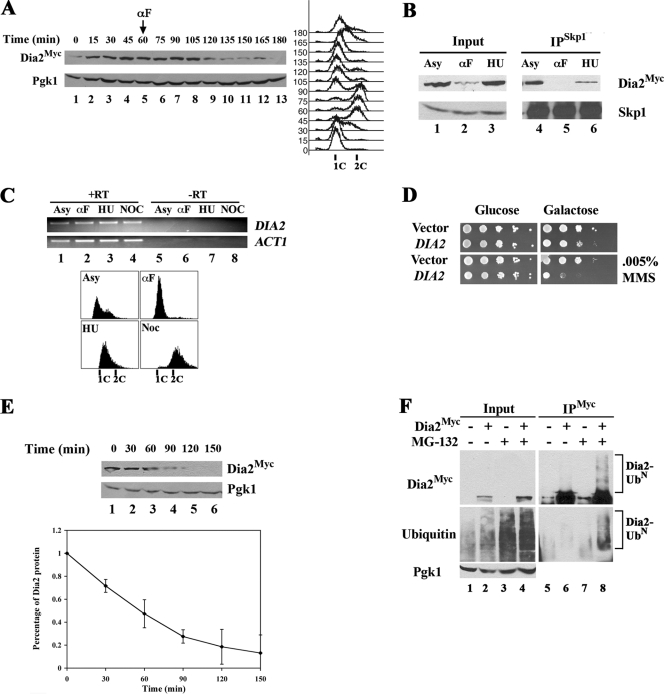FIG. 2.
Dia2Myc protein abundance fluctuates throughout the cell cycle. (A) Dia2 protein levels in synchronized cells. The 9MYC-DIA2 strain was synchronized in G1 with α-factor pheromone and released into rich medium at 30°C. After 60 min, α-factor was added back to the medium for rearrest in G1. Immunoblots were probed with anti-myc or anti-Pgk1 (as a loading control) antibodies. Cell cycle progression was monitored by flow cytometry. (B) Dia2Myc associates with Skp1 during S phase. Skp1 was immunoprecipitated with anti-Skp1 antibodies (36) from Dia2Myc lysates from asynchronous (Asy), α-factor (αF), or HU-arrested cultures. Immunoblots were probed with anti-myc or anti-Skp1 antibodies. WT, wild type. (C) DIA2 transcript abundance does not fluctuate. Total RNA was extracted and RT-PCR was performed as described in Materials and Methods. ACT1 was monitored as a control. Cell cycle stage was monitored by flow cytometry. (D) DIA2 overexpression leads to a growth defect in the presence of MMS. Wild-type cells containing empty vector or DIA2 under the control of the GAL1,10 promoter were spotted in 10-fold serial dilutions to minimal medium with 2% glucose or 2% galactose. Plates were incubated at room temperature. MMS was included at the indicated amount. (E) Dia2 is an unstable protein. Dia2Myc cells were treated with 100 μg/ml CHX and samples taken every 30 min. Samples were immunoblotted with anti-myc antibodies, and anti-Pgk1 antibodies were used to control for loading. Quantitation of three independent experiments is shown on the graph. Error bars indicate standard deviations. (F) Dia2Myc is ubiquitinated. Wild-type or Dia2Myc cells were treated with DMSO (lanes 1 and 2) or MG132 (lanes 3 and 4) for 90 min and immunoprecipitated with anti-myc antibodies (lanes 5 to 8) and immunoblotted with anti-myc or antiubiquitin (Ub) antibodies. Pgk1 was monitored as a loading control.

